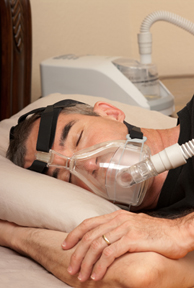Free Case Evaluation
You will never be charged a fee unless a recovery is made for you.
We are no longer accepting new cases.
CPAP, which stands for continuous positive airway pressure, and bi-level PAP (BiPAP) machines are used to supply oxygen and support breathing. These devices include a fitted mask and are commonly prescribed to treat sleep apnea, a condition in which a person repeatedly starts and stops breathing during sleep. They are sometimes used to provide noninvasive breathing support for hospitalized patients in respiratory distress who do not want to be on a ventilator, or patients with neuromuscular weakness, such as those with amyotrophic lateral sclerosis (ALS).

Philips Respironics, a major manufacturer of bi-level positive airway pressure (BiPAP), continuous positive airway pressure (CPAP), and mechanical ventilator devices, has recalled millions of units, in part because of the possible carcinogenic effects of a foam used in the devices. As a result, CPAP lawsuits are being filed against Phillips Respironics.
A CPAP (continuous positive airway pressure) machine sends a steady flow of oxygen into the wearer’s mouth and nose to keep their airways open and help them breath normally. The machine’s motor generates a continuous stream of pressurized air that travels through an air filter into a flexible tube fitted into a mask that is sealed around the user’s mouth and nose. As the user sleeps, the machine pushes against any blockages, opening their airways to keep them breathing continuously and normally.
CPAP machines may have different styles of masks to accommodate the user’s comfort and to address their particular type of apnea.
A bi-level PAP machine is similar to a CPAP machine except that it delivers pressurized air at two alternating levels. The intake pressure is higher, supporting the patient while they breathe in, while the pressure is lower when the user breathes out. The patient’s sleep doctor prescribes the pressure settings so the machine supports and matches the user’s breathing pattern.
Other variations of bi-level PAP machines include more sophisticated settings to control the timing, length, and volume of breaths delivered.
Bi-level PAP, BiPAP, and VPAP machines are all bi-level PAP machines. Philips Respironics calls its bi-level PAP machines BiPAP and has registered BiPAP as a trademark. ResMed, another major manufacturer, calls its bi-level PAP machines VPAP (variable positive airway pressure).
When does a doctor prescribe CPAP and when is BiPAP more appropriate? A CPAP machine is usually prescribed first to treat sleep apnea. But if the patient can’t tolerate continuous positive airway pressure, the doctor may recommend changing to a bi-level PAP. A doctor may also recommend bi-level PAP from the start for a patient who finds it difficult to breathe out against the pressure supplied by the CPAP machine.
Bi-level PAP breathing support is also often used to treat central sleep apnea, a condition associated with opioid use, stroke, and congestive heart failure. It may also be employed if the patient’s apnea is more severe obstructive sleep apnea.
Bi-level PAP machines are considerably more expensive than CPAP machines.
Sources
Antonescu-Turcu, A., and S. Parthasarathy. (2011, June 22). CPAP and Bi-level PAP Therapy: New and Established Roles. Retrieved from https://www.ncbi.nlm.nih.gov/pmc/articles/PMC3119924/
Asp, K. (2015, June 30). What is CPAP (Continuous Positive Airway Pressure) Therapy? Retrieved from https://www.aastweb.org/blog/what-is-cpap-continuous-positive-airway-pressure-therapy
Bomey, N. (2021, June 15). Philips recalls sleep apnea machines, ventilators over cancer risk. Retrieved from https://www.usatoday.com/story/money/2021/06/15/philips-recall-sleep-apnea-machines-ventilators-cpap-bi-level-pap/7698074002/
Davis, K. (2020, December 17). What you need to know about sleep apnea. Retrieved from https://www.medicalnewstoday.com/articles/178633
Donovan, J. (2016, May 2). How to Sleep Easier With Your CPAP Machine. Retrieved from https://www.webmd.com/sleep-disorders/sleep-apnea/features/cpap-machine
Mayo Clinic Staff. (2020, July 28). Sleep apnea. Retrieved from https://www.mayoclinic.org/diseases-conditions/sleep-apnea/symptoms-causes/syc-20377631
MedicineNet. (2020, March 31). What is CPAP Therapy. Retrieved from https://www.medicinenet.com/what_is_cpap_therapy/article.htm
Nasca, T. (n.d.). Difference between CPAP, AutoCPAP and BiLevel devices. Retrieved from https://www.sleepapnea.org/treat/cpap-therapy/choosing-a-pap-machine/difference-between-cpap-auto-cpap-bilevel/
National Heart, Lung, and Blood Institute. (n.d.). Sleep Apnea. Retrieved from https://www.nhlbi.nih.gov/health-topics/sleep-apnea
Peters, B. (2019, December 1). Using BiPAP Therapy for to Treat Sleep Apnea. Retrieved from https://www.verywellhealth.com/what-is-bipap-3015273
Philips. (n.d.). Medical Device recall notification (U.S. only) / field safety notice (International Markets); Philips Respironics. Retrieved from https://www.usa.philips.com/healthcare/e/sleep/communications/src-update#top
Philips. (n.d.). URGENT: Field Safety Notification. Retrieved from https://www.philipssrcupdate.expertinquiry.com/
Pinto, V., and S. Sharma. (2021, May 7). Continuous Positive Airway Pressure. Retrieved from https://www.ncbi.nlm.nih.gov/books/NBK482178/
Sleephealth.org. (2017, August 31). What is a Bi-PAP or Bi-Level Machine? Retrieved from https://www.sleephealth.org/ufaqs/bi-pap-bi-level-machine/
Stanborough, R. (2020, August 18). What’s a CPAP Machine, and How Does It Work? Retrieved from https://www.healthline.com/health/what-is-a-cpap-machine
You will never be charged a fee unless a recovery is made for you.